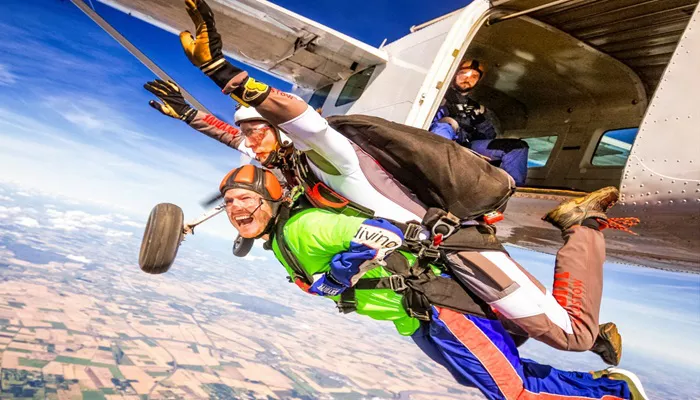Tandem skydiving is one of the most exhilarating experiences for thrill-seekers worldwide. Unlike solo skydiving, where individuals jump alone, tandem skydiving pairs the participant with a highly trained instructor who controls the jump from start to finish. This setup makes tandem skydiving accessible even to complete beginners. However, one of the most common concerns for first-time jumpers is safety. A crucial question arises: What is the injury rate for tandem skydiving?
This article delves into the statistics, risk factors, and measures taken to ensure tandem skydiving remains one of the safest extreme sports.
Understanding the Safety of Tandem Skydiving
Tandem skydiving is considered one of the safest forms of skydiving. The presence of an experienced instructor, strict safety regulations, and advanced parachute technology significantly reduce the risk of injuries. But how do these factors translate into actual numbers?
According to the United States Parachute Association (USPA), tandem skydiving has a remarkably low injury rate. With over 3 million jumps occurring annually, statistics show that injuries are rare, and fatalities even rarer.
What Is the Injury Rate for Tandem Skydiving?
The USPA reports that the injury rate for tandem skydiving is approximately 1 in 500 jumps. While this may sound concerning at first, it is important to note that most of these injuries are minor and non-life-threatening. Common injuries include:
Ankle sprains or twists due to improper landing.
Minor bruises from harness straps.
Soft tissue injuries from unexpected hard landings.
Comparing Tandem Skydiving to Other Extreme Sports
To put tandem skydiving’s injury rate into perspective, let’s compare it to other popular extreme sports:
Bungee Jumping: 1 in 500,000 jumps results in serious injury.
Snowboarding: 3 to 6 injuries per 1,000 participants per day.
Motorcycle Racing: 1 in 1,000 crashes results in fatality.
Scuba Diving: 1 in 200,000 dives results in fatality.
Clearly, while tandem skydiving does have some risks, it remains one of the safer extreme sports available today.
What Are the Most Common Causes of Tandem Skydiving Injuries?
Although tandem skydiving is well-regulated, a few factors can contribute to injuries, including:
Hard Landings
One of the leading causes of injuries in tandem skydiving is a hard landing. This can occur due to:
Strong winds affecting the parachute’s descent.
Inadequate body positioning upon landing.
Incorrect flare timing (when the instructor slows the descent before touchdown).
Equipment Malfunctions
Although modern skydiving equipment is highly reliable, malfunctions do happen. However, all tandem parachutes are equipped with a main parachute and a reserve parachute in case of emergency.
Poor Weather Conditions
Weather plays a critical role in tandem skydiving safety. High winds, rain, and turbulence can impact the jump, increasing the risk of injury. This is why jumps are often postponed if weather conditions are unfavorable.
Measures That Improve Safety in Tandem Skydiving
Skydiving safety has improved significantly over the years due to advancements in equipment and stricter regulations. Here are key measures taken to ensure tandem skydiving remains safe:
Certified Instructors
All tandem instructors must be certified by recognized organizations such as the USPA. This includes:
Completing hundreds of solo jumps before becoming a tandem instructor.
Undergoing extensive safety training.
Learning emergency procedures and how to handle various in-air situations.
State-of-the-Art Equipment
Modern tandem skydiving equipment includes:
Automatic Activation Devices (AADs) that deploy the reserve parachute if needed.
Dual parachute systems (main and reserve) for added safety.
Ergonomic harnesses that ensure a secure attachment between the jumper and the instructor.
Pre-Jump Training for Participants
Before every tandem skydive, participants undergo a thorough briefing, which includes:
Proper body positioning for freefall.
How to assist with the landing to avoid injury.
What to expect during the jump to reduce panic and ensure smooth execution.
What Are the Chances of a Fatality in Tandem Skydiving?
While the injury rate is low, many people also ask about fatality rates. According to the USPA, the fatality rate for tandem skydiving is 1 in 500,000 jumps. To put that into perspective, you are more likely to be struck by lightning than to die in a tandem skydive.
Conclution
Tandem skydiving is one of the safest extreme sports, thanks to rigorous training, cutting-edge technology, and professional oversight. While minor injuries can happen, the risk of serious injury or fatality is extremely low.
If you’re considering a tandem skydive, remember:
Follow all instructions given by your instructor.
Maintain the correct body position during freefall and landing.
Choose a reputable skydiving center with certified instructors.
By taking these precautions, you can enjoy the thrill of tandem skydiving with peace of mind, knowing that the risks are minimal compared to the incredible experience of freefalling from thousands of feet above the ground!


